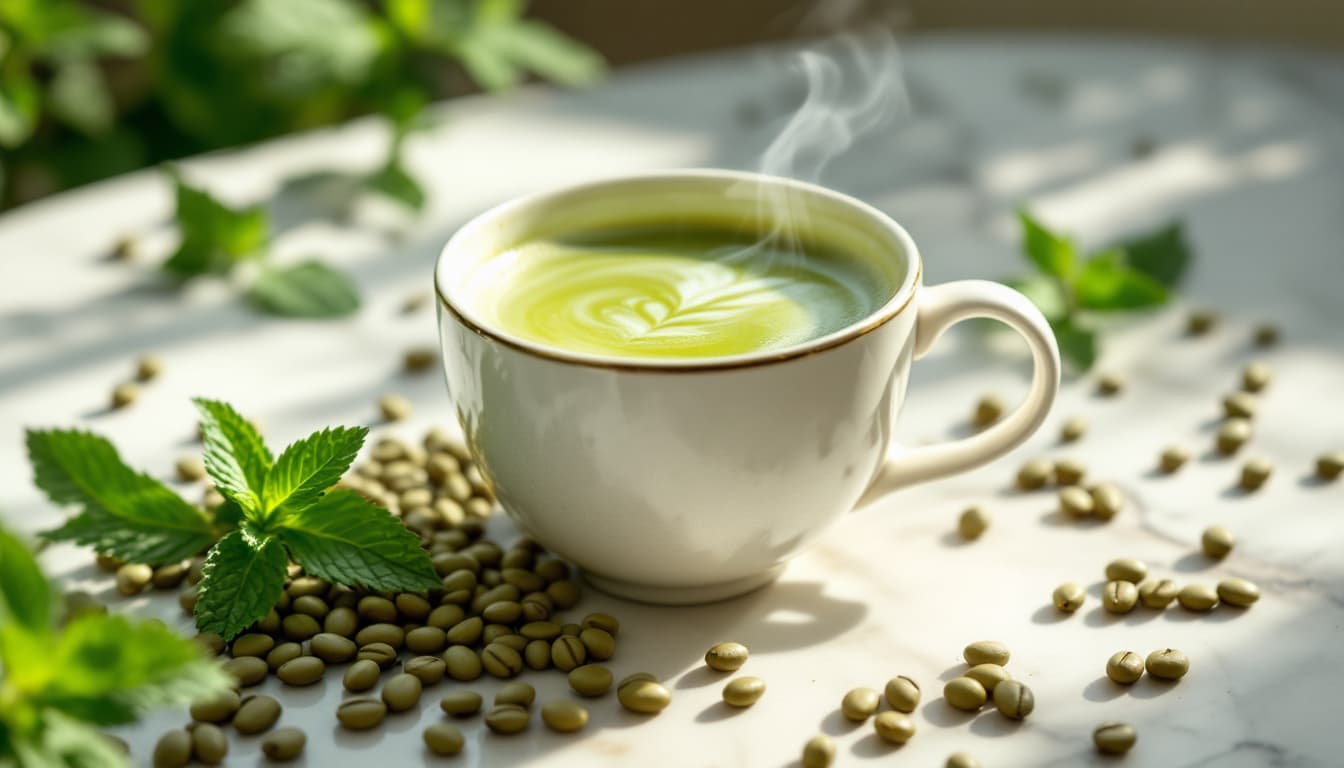Curious if green coffee is better for you than your daily brew?
Here’s the simple answer to “What is the difference between green coffee and regular coffee?”
Green coffee is raw, unroasted beans that keep more antioxidants, especially chlorogenic acid.
Regular coffee is roasted for that rich, familiar taste, but roasting breaks down some of those delicate compounds.
If you care about flavor and wellness, this matters. Green coffee has a mild, grassy taste, and it may support healthy blood sugar and metabolism.
Regular coffee brings bold aroma, steady energy, and proven perks for focus and mood.
Both can fit a healthy routine, as long as you drink them the smart way.
In this post, we’ll cover the basics, the key differences, and easy health tips you can use right away.
We’ll also look at how a simple add-in, like Java Burn, might boost benefits for energy and metabolism, and when it makes sense.
If you’re curious about safety and results, start with our honest insights on Java Burn effectiveness.
Brew Your Burn readers love coffee, wellness, and feeling good without fuss. You’ll get clear guidance on how to sip for taste, choose what suits your goals, and keep things safe and simple.
Ready to see how your cup can do more for you, without losing the joy of a great brew?
What Exactly is Green Coffee?
 Photo by Kelly
Photo by Kelly
Green coffee is simply the raw seed of the coffee cherry before roasting. It looks pale to dull green, feels dense, and smells earthy.
If you are wondering what the difference is between green coffee and regular coffee, it comes down to heat.
Regular coffee is roasted, which builds flavor but lowers some delicate plant compounds.
Green coffee keeps those compounds closer to their natural form.
How Green Coffee is Processed and What It Looks Like
Coffee cherries are harvested when ripe, then the fruit is removed and the seeds are cleaned.
Next, the beans are dried with airflow and time, not heat from roasting. This slow drying keeps the beans raw and greenish.
Here is how it compares to roasting:
- Green beans: small, matte, pale or olive green, with a grassy smell. They look more like dried seeds than something you would brew.
- Roasted beans: larger from expansion, shiny or satin brown, with a bold coffee aroma. They look ready to grind and brew.
Why this matters for nutrition:
- Less heat means more fragile compounds remain, including chlorogenic acids. These are plant antioxidants that support healthy blood sugar and overall wellness.
- Early studies suggest benefits, although findings vary. For a balanced overview, see Healthline’s review of green coffee benefits, weight loss, and side effects.
Smart sourcing tip:
- Choose beans from farmers who care for soil, water, and workers. A good starting point is learning about sustainable practices in coffee-growing regions.
- Explore our guide to sustainable coffee farming practices to see how eco-friendly methods can improve bean quality and community health.
The Unique Taste and Everyday Uses of Green Coffee
Green coffee does not taste like your morning latte. It is mild, a little sour, and more tea-like than coffee-like.
Think of light herbal tea with a hint of citrus pith. Many people find it too sharp to drink black, and that is okay.
Practical ways to use it:
- Brew it like tea: Lightly crush or grind the beans, then steep in hot water for 8 to 10 minutes. Add lemon, ginger, or a touch of honey to soften the tart edge.
- Use a powder: Green coffee bean extract shows up in capsules and drink mixes. It is popular for weight management and metabolic support. Curious about what researchers say? This overview on taste, benefits, and risks of green coffee breaks it down in plain language.
Wellness tie-in:
- Energy without heavy jitters: Green coffee can feel smoother for some people, especially if caffeine makes them edgy. Start small and see how your body responds.
- May support healthy blood sugar: Early research links chlorogenic acids with better glucose control in some adults. Results vary, so keep expectations realistic and check with your healthcare provider if you take medication.
How to pair it with your regular coffee routine:
- Swap one cup: Replace your afternoon coffee with a green coffee tea to reduce late-day caffeine.
- Mix and match: Enjoy your morning espresso, then use green coffee extract later for a lighter lift.
- Be supplement smart: If you use a metabolism-supporting supplement, take the lowest effective dose and avoid stacking with high-caffeine drinks. Space out servings and drink water.
Helpful tips to get the most from both:
- Go slow: Try green coffee 2 to 3 times a week before switching daily.
- Taste tweak: Add citrus peel, mint, or cinnamon to balance the sour notes.
- Check labels: Capsules and powders vary in chlorogenic acid content. Look for transparent dosing and third-party testing.
Key takeaways:
- Green coffee is unroasted, so it stays pale and more nutrient-dense.
- Flavor is mild and tea-like, not bold like roasted coffee.
- May support blood sugar and steady energy, but results are individual.
- Ethical sourcing matters, and sustainable farming can improve quality.
- Pair with your regular coffee by swapping a cup or using a gentle extract.
Breaking Down Regular Coffee We All Know and Love
 Photo by Thirdman
Photo by Thirdman
If you are asking, What is the difference between green coffee and regular coffee?, the short answer is roasting.
Regular coffee is simply green beans that have been heated until they brown, puff, and develop flavor.
That heat unlocks the aroma you know, and it changes how the beans taste, smell, and brew. Here is how it works and why your morning cup hits the spot.
The Roasting Magic That Transforms Coffee Beans
Roasting turns hard, grassy-smelling green beans into the rich brown beans we grind.
It is a simple path with big changes along the way.
- Heat up: Beans are roasted to about 350 to 550°F. They start pale green, then shift to yellow.
- Browning phase: As temperature climbs, sugars and amino acids react. This is the Maillard reaction, a key step that builds caramel, nut, and toast notes. For a visual primer, check this clear overview of the Maillard reaction in coffee roasting.
- First crack: Water turns to steam, pressure rises, and beans pop. Now they smell like coffee.
- Choose the roast: Pull early for a light roast, leave longer for medium, and push deeper for dark. Each step changes flavor, body, and bitterness.
- Cool fast: Rapid cooling locks in the flavors you want and stops over-roasting.
Light roasts taste brighter and show off the bean’s origin. Dark roasts taste bolder, with more chocolate, smoke, and lower acidity.
Either way, roasting makes caffeine easier to extract in your brew, which often means a steady energy lift without feeling flat.
Want the science cheat sheet? The American Chemical Society’s infographic on why coffee tastes and smells delicious breaks down the key reactions in simple terms.
Flavor Profiles and Why Regular Coffee Tastes So Good
Regular coffee tastes great because the roast meets the origin. That pairing builds the flavors you notice in the cup.
- Fruity Ethiopian: Often light roasted, with berry, citrus, and floral notes. Think juicy and bright.
- Bold Italian-style espresso: Usually darker roasted, with cocoa, toasted sugar, and a thicker feel.
- Nutty Brazil: Medium roast brings almond, milk chocolate, and a smooth finish.
- Balanced Colombia: Medium to medium-dark offers caramel, red fruit, and clean sweetness.
Why it can feel addictive yet still fit a healthy life:
- Caffeine boosts focus and mood by blocking adenosine, a sleep signal in the brain. This feels rewarding, which is why your brain wants another sip.
- Coffee, in smart amounts, is linked with better alertness and a lower risk of certain health issues in adults. The key is balance and timing.
- Too much can cause jitters or poor sleep. Keep tabs on how your body responds.
Simple tips to get more flavor and benefits, with fewer downsides:
- Buy fresh, use fresh: Choose whole beans with a clear roast date and use them within 2 to 4 weeks. Grind just before brewing.
- Pick the right roast for your goal:
- Light to medium for a more original character and a brighter cup.
- Medium to dark for richer, chocolatey notes and smooth body.
- Mind the add-ins: Sugar and heavy syrups can drown flavor and add calories. Try cinnamon, a splash of milk, or a dash of vanilla instead.
- Brew in the sweet spot: Use hot water around 195 to 205°F, and aim for the right grind size for your method. This helps extract caffeine and flavor evenly, so you get a clear taste and steady energy.
- Stop late-day overdoing: If sleep is tough, set a caffeine cutoff in the afternoon.
Key takeaway: Roasting unlocks the aroma, flavor, and easy-to-extract caffeine that define regular coffee.
It is why your espresso tastes chocolatey and your pour-over tastes bright. Green coffee keeps more raw plant compounds, while regular coffee gives you the classic cup you crave.
Key Differences Between Green and Regular Coffee Explained
 Photo by Michael Burrows
Photo by Michael Burrows
If you are asking, What is the difference between green coffee and regular coffee?, it starts with roasting. Green coffee is raw and keeps more fragile plant compounds.
Regular coffee is roasted, which builds flavor and aroma, but changes the nutrition profile.
Think of it like food: green coffee is the fresh veggie version, regular coffee is the cooked meal. Both can be great; they just do different things for your body and your day.
Nutritional Showdown: Antioxidants, Caffeine, and More
Both types come from the same bean, but heat changes the balance.
- Chlorogenic acids (CGAs): Green coffee is higher in CGAs, the antioxidants linked to fat metabolism and healthy blood sugar. Roasting lowers some CGAs, but regular coffee still has a helpful mix of antioxidants from roasting reactions.
- Roast-created compounds: Regular coffee gains new flavor molecules and antioxidant activity during roasting, which is why your cup smells rich and tastes complex.
- Caffeine: Caffeine depends on how you brew. Green coffee beverages often deliver less caffeine per cup than regular coffee. Many sources report green coffee provides about 25 to 50 percent of the caffeine of regular coffee, which lines up with guidance from WebMD’s green coffee overview.
Simple comparison you can picture:
- Green coffee = fresh veggies: Brighter, more delicate nutrients like CGAs.
- Regular coffee = cooked meal: Some nutrients change, but you gain deep flavor and new beneficial compounds.
Quick cheat sheet:
- If fat-burning support and blood sugar balance are your goals, green coffee’s CGAs may help your plan when paired with healthy eating and movement.
- If you want bold taste and steady energy, regular coffee is your daily driver.
- Curious how coffee’s antioxidants stack up to tea? See our friendly comparison of coffee vs. tea health benefits.
How These Differences Affect Your Health and Daily Routine
Your choice can match your goals, mood, and schedule.
- Green coffee for targeted support: Many people use green coffee extract as a supplement for metabolism or glucose control. It is lighter on caffeine for many drinkers, so it can feel smoother.
- Regular coffee for enjoyment and focus: Roasted coffee delivers the classic taste and a familiar energy lift that helps with work, workouts, and mood.
Practical ways to use both without overdoing it:
- Start your day with your regular brew for flavor and focus. If you want a little extra metabolic support, add a green coffee extract to your routine, or use a measured product you trust. Keep caffeine totals in mind.
- Try a mix-and-match week: Regular coffee most mornings, green coffee tea or extract on lighter days or later in the afternoon.
- Watch your caffeine ceiling. Many healthy adults do well staying under about 400 mg per day. Green coffee drinks can still add up. WebMD’s guidance on green coffee basics and side effects is a helpful reference.
Tips for feeling energized and healthy:
- Hydrate early: Drink water with your first cup to avoid the mid-morning crash.
- Time it right: If sleep is an issue, set a caffeine cutoff 6 to 8 hours before bed.
- Pair with protein: Coffee on an empty stomach can feel edgy for some. A small snack can smooth the ride.
- Keep expectations real: Green coffee and roasted coffee can support your goals, but they work best with good habits, like smart meals, movement, and steady sleep.
Bottom line for busy mornings:
- Use regular coffee for taste and productivity.
- Use green coffee when you want a lighter lift or extra support from CGAs.
- If you enjoy both, that is fine. Just track total caffeine and listen to your body.
Unlocking Health Benefits: Tips for Coffee Lovers
Curious about what the difference is between green coffee and regular coffee?
Here is the simple goal of this section: help you drink both in a way that feels good, tastes great, and supports your health.
Small choices make a big difference, from how you brew to what you add, and when supplements make sense.
Smart Ways to Brew and Enjoy Regular Coffee at Home
 Photo by Dziana Hasanbekava
Photo by Dziana Hasanbekava
You can brew a clean, tasty cup without fancy gear. Here are simple, repeatable steps.
Pour-over, step by step:
- Heat water to about 200°F. Boil, then rest 30 seconds.
- Rinse the paper filter to remove paper taste and warm the dripper.
- Grind medium-fine, like table salt. Start with 1 to 2 tablespoons per 6 ounces of water.
- Bloom the grounds with a splash of hot water for 30 seconds.
- Pour in slow circles, keeping the bed just covered. Aim for a 3 to 4 minute brew.
French press, step by step:
- Grind coarse, like sea salt. Use 1 to 2 tablespoons per 6 ounces of water.
- Add grounds to the press, then pour hot water.
- Stir gently, place the lid, and brew 4 minutes.
- Press down slowly. Serve right away to avoid bitterness.
Affordable starter gear:
- Manual grinder: Even grind makes a smoother cup. Hand grinders are budget-friendly.
- Digital scale: Helps you repeat your best brew. A small kitchen scale works.
- Gooseneck kettle: More control for pour-over. A basic stovetop version is enough.
- Reusable metal filter or sturdy press: Low waste, built to last.
Health twist without losing joy:
- Drink black or with minimal add-ins. Try a splash of milk, a dusting of cinnamon, or a drop of vanilla. Skip heavy syrups most days.
- Time your coffee. Morning and early afternoon help you avoid sleep issues.
- Keep portions reasonable. Many adults do well with 1 to 3 cups per day, which aligns with large reviews on coffee and health. For a balanced overview, see Mayo Clinic’s guide on what research says about coffee and health.
Quick flavor tips:
- Fresher beans taste better. Use within a few weeks of the roast date.
- Grind right before brewing.
- If your cup tastes sour, grind finer. If it tastes bitter, grind coarser.
Incorporating Green Coffee Supplements Without Risks
Green coffee supplements can support energy and metabolism, especially if you want less caffeine than a strong brew.
A popular option is Java Burn, which mixes into your coffee to help boost calorie burn while you go about your day.
How to add it to your routine:
- Stir one serving into your morning cup. Hot coffee helps it dissolve well.
- Drink water with it. Hydration smooths caffeine’s edge.
- Start low. Use the standard serving for two weeks before adjusting.
Who should skip or be careful:
- Pregnant or breastfeeding individuals should avoid coffee-based supplements.
- Anyone with heart issues, high blood pressure, or anxiety should check with a clinician.
- If you take meds for thyroid, blood pressure, or diabetes, ask your pharmacist or doctor about possible interactions.
- Sensitive to caffeine? Try half a serving or use it with a smaller cup.
What benefits to expect:
- Energy support for focused mornings.
- Metabolism support when paired with balanced meals and movement.
- A routine that stacks with habits you already have, like daily coffee.
Smart use tips:
- Avoid pairing with other stimulants. Skip extra energy drinks on the same day.
- Do not use near bedtime.
- Track how you feel for a week. Look for steady energy and no jitters.
Want a neutral look at safety and side effects? Cleveland Clinic explains the common pros and cons of green coffee extract in their guide to green coffee bean extract risks and benefits.
Key point: Supplements can help, but the base still matters.
Sleep, simple meals, and steady movement are the foundation. Use supplements to support, not replace, those basics.
Key Takeaways
- The core of what is the difference between green coffee and regular coffee is roasting. Green coffee keeps more chlorogenic acids, and regular coffee delivers classic flavor and aroma.
- Brew simply at home for better taste and control. Fresh grind, right temperature, and a steady recipe.
- Black coffee or light add-ins give you more benefits with fewer calories.
- Green coffee supplements, like Java Burn, can support energy and fat burn when used with care.
- Safety first. Check interactions, start low, and listen to your body.
Quick Summary
Use regular coffee for flavor and focus, and keep it simple to get the most from each cup.
Add a green coffee supplement if your goal is extra metabolic support, and do so with smart timing and clear limits.
Your daily habits carry most of the weight, and coffee can fit in nicely.
FAQs
- What is the difference between green coffee and regular coffee?
Green coffee is unroasted and higher in chlorogenic acids. Regular coffee is roasted for rich flavor and easy brewing. - Is black coffee healthy?
Black coffee can be part of a healthy routine. It offers antioxidants and can support mood and focus when you stay within your caffeine limit. - How many cups of coffee are safe per day?
Many adults do well with 1 to 3 cups. Total caffeine under about 400 mg per day is a common guideline. - What is the easiest way to start brewing at home?
Choose pour-over or French press. Get a basic grinder, a small scale, and learn one recipe well. - Do I need a special kettle for pour-over?
A gooseneck kettle helps with control, but a regular kettle works. Pour slowly and evenly. - How do I use a green coffee supplement like Java Burn?
Stir it into your morning cup, hydrate, and start with the standard serving. Avoid other stimulants on the same day. - Who should avoid green coffee supplements?
People who are pregnant, breastfeeding, or sensitive to caffeine. Anyone on certain medications should check with a clinician first.
Final Note
How does coffee, including supplements like Java Burn, fit into a healthy life? Keep your base strong with sleep, simple meals, and movement.
Enjoy regular coffee for taste and focus, and add a trusted supplement when you want an extra nudge.
Stay mindful, start small, and make choices that help you feel steady and well.
Conclusion
What is the difference between green coffee and regular coffee? Green coffee is raw and higher in chlorogenic acids, which may support healthy blood sugar and fat metabolism.
Regular coffee is roasted, richer in flavor, and great for focus and mood. Think green for raw power, regular for daily joy.
Both can fit a healthy life when you sip mindfully.
Choose what serves your goal today. Keep portions steady, hydrate, and avoid late caffeine.
If you want extra metabolic support, consider a measured supplement and track how you feel.
Key takeaways:
- Choose based on goals, taste, and timing.
- Green coffee for chlorogenic acids and a lighter lift.
- Regular coffee for bold flavor and steady energy.
- Moderation is key, know your caffeine limit.
- Brew simply, use fresh beans and a consistent recipe.
- Pair coffee with good sleep, movement, and balanced meals.
FAQs:
- Is green coffee better for weight loss?
It may help via chlorogenic acids, but pair it with a smart diet and exercise. - How much caffeine in each?
Both can be similar, about 80 to 100 mg per cup, depending on the brew. - Can I brew green coffee?
Yes. Steep lightly crushed beans like tea. Expect a mild, grassy taste. - Safe for kids?
Talk with a doctor first. Keep caffeine low or skip it. - Best equipment for regular coffee?
Start with a simple drip maker or French press. Fresh grind helps. - Java Burn side effects?
Most are mild for healthy adults. Start with one serving and avoid other stimulants. - Ethical sourcing?
Look for fair trade or direct trade labels, and roasters who share farm details.
Quick answer: Coffee, including supplements like Java Burn (https://brewyourburn.com/JavaBurn), fits a healthy life by offering antioxidants and energy when enjoyed with smart habits, exercise, and good eats.
Try a new brew today.






